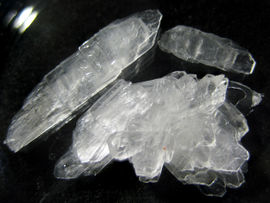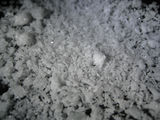Urea nitrate
 Large urea nitrate crystals
| |
| Names | |
|---|---|
| IUPAC name
Urea nitrate
| |
| Other names
Carbamide nitrate
Urea hydronitrate Urea mononitrate Uronium nitrate | |
| Properties | |
| CH5N3O4 | |
| Molar mass | 123.068 g/mol |
| Appearance | White solid |
| Odor | Odorless |
| Density | 1.69 g/cm3 |
| Melting point | 163 °C (325 °F; 436 K) |
| Boiling point | Decomposes |
| 15 g/100 ml | |
| Solubility | Soluble in ethanol Insoluble in hydrocarbons |
| Solubility in acetone | 3.7 g/100 g (30 °C)[1] |
| Solubility in ethanol | 50.5 g/100 g (30 °C)[2] |
| Solubility in methanol | 11.65 g/100 g (30 °C)[3] |
| Vapor pressure | ~0 mmHg |
| Thermochemistry | |
| Std enthalpy of
formation (ΔfH |
525.89 kJ/kmol |
| Hazards | |
| Safety data sheet | Pfaltz&Bauer |
| Related compounds | |
| Related compounds
|
Ammonium nitrate Guanidinium nitrate Methylammonium nitrate |
| Except where otherwise noted, data are given for materials in their standard state (at 25 °C [77 °F], 100 kPa). | |
| Infobox references | |
Urea nitrate is the nitrate salt of the organic base urea. It is an explosive material used in various applications, but it has gained a bad reputation due to its use in many terrorists plots, such as the World Trade Center bombing in 1993.
Urea nitrate should not be confused with nitrourea, which is a nitroamine and not a nitrate ester.
Contents
Properties
Chemical
Urea nitrate is unstable in basic solution. It also hydrolyzes in solution, which is quite acidic (urea being a very weak base); hot water causes the hydrolysis to proceed more fully, and nitric acid can be distilled back from the solution if heated enough.
Physical
Urea nitrate is a white solid, sparingly soluble in water (less so than urea itself). Its solubility in cold water is significantly less than in warm water.
Explosive
Urea nitrate is an explosive with an average detonation velocity of 4,000 m/s (depending on the purity, it can be between 3,400 m/s and 4,700 m/s). Its destructive properties are similar to that of ammonium nitrate-based explosives.
Availability
Due to being an explosive material, the sale of urea nitrate is restricted.
Preparation
Urea nitrate can be prepared by reacting urea with nitric acid. The reaction is exothermic, so it's best to do it at low temperatures.
Urea nitrate can be prepared via a double replacement by combining urea with a nitrate salt and concentrated hydrochloric acid in water. Gentle heat, as from a water bath, should be added to bring the urea and nitrate into solution before the HCl is added. The turbid solution clears as the HCl is added and a copious precipitate of urea nitrate is obtained when the solution is cooled below 0 Celsius. The remaining solution contains a small amount of product and the chloride salt of the cation whose nitrate was used.[4]
Projects
- Make blasting charges
- Prepare Urea nitrate from assorted nitrates, recovering the chloride in each case.
Handling
Safety
Urea nitrate appears to be a flame retardant. Filter paper soaked in it and dried will char in a butane lighter flame but not catch fire.
Storage
Storage should be limited to very small amounts, as larger amounts may invite visits by Les Gendarmes.
Disposal
Casual tests are planned to evaluate using urea nitrate as a house plant food.
Gallery
References
- ↑ Tokuoka, M.; Morooka, H.; Bull. Agr. Chem. Soc. Japan; vol. 10; (1934); p. 127 - 129
- ↑ Tokuoka, M.; Morooka, H.; Bull. Agr. Chem. Soc. Japan; vol. 10; (1934); p. 127 - 129
- ↑ Tokuoka, M.; Morooka, H.; Bull. Agr. Chem. Soc. Japan; vol. 10; (1934); p. 127 - 129
- ↑ Making Urea Nitrate without Nitric Acid
